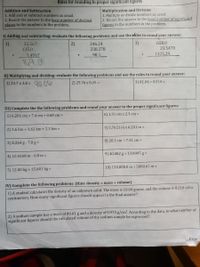
Chemistry
10th Edition
ISBN: 9781305957404
Author: Steven S. Zumdahl, Susan A. Zumdahl, Donald J. DeCoste
Publisher: Cengage Learning
expand_more
expand_more
format_list_bulleted
Question
Just want to say thank you.

Transcribed Image Text:Rules for rounding to proper significant figures
Addition and Subtraction
1. Add and or subtract numbers as usual.
2. Round the answer to the least number of decimal
places in the numbers in the problem.
Multiplication and Division
1. Multiply or divide numbers as usual.
2. Round the answer to the least number of significant
figures in the numbers in the problem.
I) Adding and subtracting: evaluate the following problems and use the rliles to round your answer:
3)
658.0
246.24
238.278
1)
32.567
2)
135.00
23.5478
1.4567
98.3
1325.29
169.01
II) Multiplying and dividing: evaluate the following problems and use the rules to round your answer:
1) 23.7 x 3.8 = 90.06
3) 81.04 + 0.010 =
2) 25.76 x 0.25 =
III) Complete the the following problems and round your answer to the proper significant figures:
1) 6.201 cm + 7.4 cm + 0.68 cm =
6) 1.31 cm x 2.3 cm =
7) 5.7621 m x 6.201 m =
2) 1.6 km + 1.62 km + 2.3 km =
8) 20.3 cm + 7.41 cm =
3) 8.264 g - 7.8 g =
9) 40.002 g + 13.0005 g =
4) 10.4168 m - 6.0 m =
10) 150,000.0 m ÷ 5000.01 m =
5) 12.00 kg + 15.001 kg =
IV) Complete the following problems: (Hint: density = mass ÷ volume)
1) A student calculates the density of an unknown solid. The mass is 10.04 grams, and the volume is 8.210 cubic
centimeters. How many significant figures should appear in the final answer?
2) A sodium sample has a mass of 80.01 g and a density of 0.970 g/cm³. According to the data, to what number of
significant figures should the calculated volume of the sodium sample be expressed?
Page
Expert Solution
This question has been solved!
Explore an expertly crafted, step-by-step solution for a thorough understanding of key concepts.
This is a popular solution
Trending nowThis is a popular solution!
Step by stepSolved in 2 steps with 1 images

Knowledge Booster
Similar questions
arrow_back_ios
arrow_forward_ios
Recommended textbooks for you
 ChemistryChemistryISBN:9781305957404Author:Steven S. Zumdahl, Susan A. Zumdahl, Donald J. DeCostePublisher:Cengage Learning
ChemistryChemistryISBN:9781305957404Author:Steven S. Zumdahl, Susan A. Zumdahl, Donald J. DeCostePublisher:Cengage Learning ChemistryChemistryISBN:9781259911156Author:Raymond Chang Dr., Jason Overby ProfessorPublisher:McGraw-Hill Education
ChemistryChemistryISBN:9781259911156Author:Raymond Chang Dr., Jason Overby ProfessorPublisher:McGraw-Hill Education Principles of Instrumental AnalysisChemistryISBN:9781305577213Author:Douglas A. Skoog, F. James Holler, Stanley R. CrouchPublisher:Cengage Learning
Principles of Instrumental AnalysisChemistryISBN:9781305577213Author:Douglas A. Skoog, F. James Holler, Stanley R. CrouchPublisher:Cengage Learning Organic ChemistryChemistryISBN:9780078021558Author:Janice Gorzynski Smith Dr.Publisher:McGraw-Hill Education
Organic ChemistryChemistryISBN:9780078021558Author:Janice Gorzynski Smith Dr.Publisher:McGraw-Hill Education Chemistry: Principles and ReactionsChemistryISBN:9781305079373Author:William L. Masterton, Cecile N. HurleyPublisher:Cengage Learning
Chemistry: Principles and ReactionsChemistryISBN:9781305079373Author:William L. Masterton, Cecile N. HurleyPublisher:Cengage Learning Elementary Principles of Chemical Processes, Bind...ChemistryISBN:9781118431221Author:Richard M. Felder, Ronald W. Rousseau, Lisa G. BullardPublisher:WILEY
Elementary Principles of Chemical Processes, Bind...ChemistryISBN:9781118431221Author:Richard M. Felder, Ronald W. Rousseau, Lisa G. BullardPublisher:WILEY

Chemistry
Chemistry
ISBN:9781305957404
Author:Steven S. Zumdahl, Susan A. Zumdahl, Donald J. DeCoste
Publisher:Cengage Learning

Chemistry
Chemistry
ISBN:9781259911156
Author:Raymond Chang Dr., Jason Overby Professor
Publisher:McGraw-Hill Education

Principles of Instrumental Analysis
Chemistry
ISBN:9781305577213
Author:Douglas A. Skoog, F. James Holler, Stanley R. Crouch
Publisher:Cengage Learning

Organic Chemistry
Chemistry
ISBN:9780078021558
Author:Janice Gorzynski Smith Dr.
Publisher:McGraw-Hill Education

Chemistry: Principles and Reactions
Chemistry
ISBN:9781305079373
Author:William L. Masterton, Cecile N. Hurley
Publisher:Cengage Learning

Elementary Principles of Chemical Processes, Bind...
Chemistry
ISBN:9781118431221
Author:Richard M. Felder, Ronald W. Rousseau, Lisa G. Bullard
Publisher:WILEY